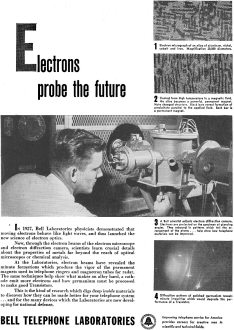|
April 1952 Radio-Electronics
 [Table of Contents] [Table of Contents]
Wax nostalgic about and learn from the history of early electronics.
See articles from Radio-Electronics,
published 1930-1988. All copyrights hereby acknowledged.
|
There is a physical limit
to how small of a distance may separate two distinct objects (line, dots, etc.),
generally agreed to be about half a wavelength of the color being observed, and
be seen with perfect human eye.
Applying that rule of thumb to blue light with a wavelength of approximately 4000 Å
(400 nm) yields a distance of 200 nm. Accordingly, there is no amount of
magnification possible which will allow a healthy human eye to resolve objects
closer together than that. Even with perfect optics, magnifications of greater
than about 1500x are not able to render greater detail. To resolve smaller
distance requires shorter wavelengths, but we cannot see them directly and need
a device to transform the detected image into a visible image. That is what an
electron microscope does to enable molecule sized particle to be "seen." The
SARS-CoV-2 particle has been measured by electron microscopy and found to
range between 50 to 140 nm, so it cannot be viewed directly with an optical
microscope. Cigarette smoke
is about 400 nm in diameter (at the limit of visible light detection) and
readily passes through masks work to "protect" against COVID (which is 1/3 the
size).
Bell Telephone Laboratories - Electrons Probe the Future
 In 1927, Bell Laboratories physicists demonstrated that moving electrons behave
like light waves, and thus launched the new science of electron optics. In 1927, Bell Laboratories physicists demonstrated that moving electrons behave
like light waves, and thus launched the new science of electron optics.
Now, through the electron beams of the electron microscope and electron diffraction
camera, scientists learn crucial details about the properties of metals far beyond
the reach of optical microscopes or chemical analysis.
At the Laboratories, electron beams have revealed the minute formations which
produce the vigor of the permanent magnets used in telephone ringers and magnetron
tubes for radar. The same techniques help show what makes an alloy hard, a cathode
emit more electrons and how germanium must be processed to make good Transistors.
This is the kind of research which digs deep inside materials to discover how
they can he made better for your telephone system ... and for the many devices which
the Laboratories are now developing for national defense.
1 - Electron micrograph of an alloy of aluminum, nickel, cobalt and iron. Magnification
20,000 diameters.
2 - Cooled from high temperature in a magnetic field, the alloy becomes a
powerful, permanent magnet. Note changed structure. Black bars reveal formation
of precipitate parallel to the applied field. Each bar is a permanent magnet.
3 - A Bell scientist adjusts electron diffraction camera. Electrons are projected
on the specimen at glancing angles. They rebound in patterns which tell the arrangement
of the atoms ... help show how telephone materials can be improved.
4 - Diffraction pattern of polished germanium reveals minute impurities which
would degrade the performance of a Transistor.
Improving telephone service for America provides careers for creative men in
scientific and technical fields.
Bell Telephone Laboratories
Posted
May 12, 2022
| Bell Telephone
Laboratories Infomercials |
-
Bell Telephone Laboratories - Time Domain Reflectometry - December 1948 Popular
Science
-
The Future Holds Great Promise - August 1949 Popular Science
-
Waveguide: 7/47 Popular Mechanics
-
Wire Wrapping - 10/1953 Popular Science
-
X-Rays, 4/60 Radio-electronics
- The Battle of
the Atoms, 4/1948 Radio News
-
The Transistor, 6/1952 Radio-Electronics
- 90-Mile Laboratory
for Telephone and Television, 6/1945 Radio News
-
Wire-Wrap, 10/53 Radio-Electronics
-
EDT Crystals, 10/47 Radio-Craft
- Germanium Refining,
5/54 Radio & TV News
- Crystal Timekeeping,
1/46 Radio News
- Transatlantic
Cable, 11/56 Radio & Television News
- Pipe Circuits,
11/48 Radio & Television News
-
Coaxial
Electron Tube, 6/54 Radio & Television News
- Thermocompression
Wire Bonding, 3/58 Radio News
-
Radio Relay Stations, 8/52 Radio & Television News
- Isolators,
6/56 Radio & Television News
- Punch
Cards, 3/55 Radio & Television News
-
Over-the-Horizon
Communications, 10/55 Radio & Television News
- Memory
Devices, 2/58 Radio & TV News
-
Adventure in Silicon, 5/55 Radio & Television News
- Pipes of Progress,
6/55 Radio & Television News
-
Project Echo, 11/60 Electronics World
|
-
Testing Phones - November 1947 Popular Science
-
Jacques Bernoulli, February 1960 Radio-Electronics
-
Type-O Carrier System, October 1952 Radio-Electronics
-
Electron Microscope, 4/1952 Radio-Electronics
-
Thermistor, 11/1946 Radio-Craft
-
Germanium Crystal, 1/1954 Radio-Electronics
-
Lens
Antenna, 5/46 Radio-Craft
- Quality Control, 6/46
Radio News Article
- Transcontinental
Radio-Relay, 10/51 Radio & TV News
- Solar
Battery, 7/54 Radio & Television News
-
Germanium Transistors, 1/54 Radio & Television News
- Cavity
Magnetron, 10/45 Radio News
-
The Cableman, 10/49 Radio & Television News
-
Coaxial Cable, 12/49 Radio & Television News
-
Tin
Whiskers, 12/55 Radio & Television News
- Relay
Contact Inspection, 7/55 Radio & Television News
- Transistor's
10th Anniversary, 6/58 Radio & Television News
-
Wire
Wrapping, 10/53 Radio & Television News
- Junction
Diode Amplifier, 11/58 Radio News
-
Nobel Prize Winners, 2/57 Radio & Television News
-
Diode Speeds Voices, 8/58 Popular Electronics
-
Microwave Relays, 7/59 Electronics World
|
|










